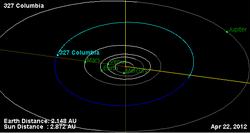Astronomy:327 Columbia
 Orbital diagram | |
| Discovery [1] | |
|---|---|
| Discovered by | A. Charlois |
| Discovery site | Nice Obs. |
| Discovery date | 22 March 1892 |
| Designations | |
| (327) Columbia | |
| Pronunciation | /kəˈlʌmbiə/[4] |
| Named after | Christopher Columbus (Italian explorer)[2] |
| 1934 JN | |
| Minor planet category | main-belt · (middle) [3] |
| Orbital characteristics [1] | |
| Epoch 16 February 2017 (JD 2457800.5) | |
| Uncertainty parameter 0 | |
| Observation arc | 124.62 yr (45,519 days) |
| |{{{apsis}}}|helion}} | 2.9496 AU |
| |{{{apsis}}}|helion}} | 2.6066 AU |
| 2.7781 AU | |
| Eccentricity | 0.0617 |
| Orbital period | 4.63 yr (1,691 days) |
| Mean anomaly | 255.97° |
| Mean motion | 0° 12m 46.44s / day |
| Inclination | 7.1462° |
| Longitude of ascending node | 354.82° |
| 306.18° | |
| Physical characteristics | |
| Dimensions | 26.13±2.8 km[5] 26.17±0.66 km[6] 26.24 km (derived)[3] 30.291±4.049 km[7] |
| Rotation period | 5.93±0.05 h[8] 5.93183±0.00005 h[9] 5.9320±0.0006 h[8] |
| Geometric albedo | 0.214±0.339[7] 0.2360±0.061[5] 0.250±0.015[6] 0.2565 (derived)[3] |
| SMASS = Sl [1] · S [3] | |
| Absolute magnitude (H) | 9.88[7] · 10.0[1][3] · 10.10[6] · 10.19±0.01[10] |
Columbia (minor planet designation: 327 Columbia) is a stony asteroid from the middle region of the asteroid belt, approximately 26 kilometers in diameter. It was discovered on 22 March 1892, by French astronomer Auguste Charlois at Nice Observatory in southeast France.[11] It is named after Christopher Columbus (1451–1506).[2]
Description
Columbia orbits the Sun at a distance of 2.6–2.9 AU once every 4 years and 8 months (1,691 days). Its orbit has an eccentricity of 0.06 and an inclination of 7° with respect to the ecliptic.[1] The body's observation arc begins the night after its official discovery at Nice.[11]
Physical characteristics
In the SMASS taxonomy, Columbia has been characterized as a Sl-type, an intermediary between the common S-type and rather rare L-type asteroids.[1]
Rotation period and spin axis
In May 2003, a rotational lightcurve of Columbia was obtained by French amateur astronomer René Roy. It gave a rotation period of 5.93 hours with a brightness variation of 0.16 magnitude ({{{1}}}).[8] In February 2007, photometric observations by his college Pierre Antonini gave a well defined period of 5.9320 hours and an amplitude of 0.42 ({{{1}}}).[8]
In 2016, a modeled lightcurve was derived from various photometric database sources, giving a concurring period of 5.93183 hours and a spin axis of (52.0°, 43.0°) in ecliptic coordinates.[9]
Diameter and albedo
According to the surveys carried out by the Infrared Astronomical Satellite IRAS, the Japanese Akari satellite, and NASA's Wide-field Infrared Survey Explorer with its subsequent NEOWISE mission, Columbia measures between 26.13 and 30.29 kilometers in diameter, and its surface has an albedo between 0.214 and 0.250.[5][6][7] The Collaborative Asteroid Lightcurve Link derives an albedo of 0.2565 and a diameter of 26.24 kilometers using an absolute magnitude of 10.0.[3]
Naming
This minor planet was named in honor of Italian explorer Christopher Columbus (1451–1506), who reached the New World during his first voyage in 1492, instead of arriving at Japan as he had intended. The asteroid was named in 1892, on the occasion of the 400th anniversary of this historic discovery. Naming citation was first mentioned in The Names of the Minor Planets by Paul Herget in 1955 (H 37).[2]
References
- ↑ 1.0 1.1 1.2 1.3 1.4 1.5 "JPL Small-Body Database Browser: 327 Columbia". Jet Propulsion Laboratory. https://ssd.jpl.nasa.gov/sbdb.cgi?sstr=2000327.
- ↑ 2.0 2.1 2.2 Schmadel, Lutz D. (2007). Dictionary of Minor Planet Names – (327) Columbia. Springer Berlin Heidelberg. p. 43. doi:10.1007/978-3-540-29925-7_328. ISBN 978-3-540-00238-3.
- ↑ 3.0 3.1 3.2 3.3 3.4 3.5 "LCDB Data for (327) Columbia". Asteroid Lightcurve Database (LCDB). http://www.minorplanet.info/PHP/generateOneAsteroidInfo.php?AstInfo=327%7CColumbia.
- ↑ Noah Webster (1884) A Practical Dictionary of the English Language
- ↑ 5.0 5.1 5.2 Tedesco, E. F.; Noah, P. V.; Noah, M.; Price, S. D. (October 2004). "IRAS Minor Planet Survey V6.0". NASA Planetary Data System 12: IRAS-A-FPA-3-RDR-IMPS-V6.0. Bibcode: 2004PDSS...12.....T. https://sbnarchive.psi.edu/pds3/iras/IRAS_A_FPA_3_RDR_IMPS_V6_0/data/diamalb.tab. Retrieved 22 October 2019.
- ↑ 6.0 6.1 6.2 6.3 Usui, Fumihiko; Kuroda, Daisuke; Müller, Thomas G.; Hasegawa, Sunao; Ishiguro, Masateru; Ootsubo, Takafumi et al. (October 2011). "Asteroid Catalog Using Akari: AKARI/IRC Mid-Infrared Asteroid Survey". Publications of the Astronomical Society of Japan 63 (5): 1117–1138. doi:10.1093/pasj/63.5.1117. Bibcode: 2011PASJ...63.1117U. (online, AcuA catalog p. 153)
- ↑ 7.0 7.1 7.2 7.3 Masiero, Joseph R.; Mainzer, A. K.; Grav, T.; Bauer, J. M.; Cutri, R. M.; Nugent, C. et al. (November 2012). "Preliminary Analysis of WISE/NEOWISE 3-Band Cryogenic and Post-cryogenic Observations of Main Belt Asteroids". The Astrophysical Journal Letters 759 (1): 5. doi:10.1088/2041-8205/759/1/L8. Bibcode: 2012ApJ...759L...8M.
- ↑ 8.0 8.1 8.2 8.3 Behrend, Raoul. "Asteroids and comets rotation curves – (327) Columbia". Geneva Observatory. http://obswww.unige.ch/~behrend/page1cou.html#000327.
- ↑ 9.0 9.1 Hanus, J.; Durech, J.; Oszkiewicz, D. A.; Behrend, R.; Carry, B.; Delbo, M. et al. (February 2016). "New and updated convex shape models of asteroids based on optical data from a large collaboration network". Astronomy and Astrophysics 586: 24. doi:10.1051/0004-6361/201527441. Bibcode: 2016A&A...586A.108H.
- ↑ Veres, Peter; Jedicke, Robert; Fitzsimmons, Alan; Denneau, Larry; Granvik, Mikael; Bolin, Bryce et al. (November 2015). "Absolute magnitudes and slope parameters for 250,000 asteroids observed by Pan-STARRS PS1 - Preliminary results". Icarus 261: 34–47. doi:10.1016/j.icarus.2015.08.007. Bibcode: 2015Icar..261...34V.
- ↑ 11.0 11.1 "327 Columbia". Minor Planet Center. https://www.minorplanetcenter.net/db_search/show_object?object_id=327.
External links
- Asteroid Lightcurve Database (LCDB), query form (info )
- Dictionary of Minor Planet Names, Google books
- Asteroids and comets rotation curves, CdR – Observatoire de Genève, Raoul Behrend
- Discovery Circumstances: Numbered Minor Planets (1)-(5000) – Minor Planet Center
- 327 Columbia at AstDyS-2, Asteroids—Dynamic Site
- 327 Columbia at the JPL Small-Body Database
 |

